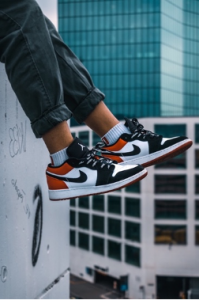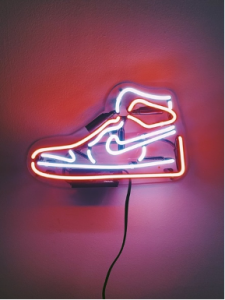Have you heard of NFTs, or non-fungible tokens? In recent years, NFTs and their associated intellectual property rights are increasingly embroiled in legal battles. One such example is Nike v. StockX, a NFT trademark case filed in the U.S. District Court for the Southern District of New York. This case demonstrates that fashion brands like Nike are willing to battle in the courtroom for intellectual property rights in NFTs.
Before discussing the specifics of the case, let’s discuss NFT basics. NFTs are one-of-a-kind virtual assets recorded in a blockchain that can take the form of image, video, or audio. A blockchain is an electronic database that stores information in a digital format. Once created, each NFT is recorded and verified in a blockchain, preventing others from duplicating or reproducing them. Nevertheless, NFTs can be bought, sold, and exchanged.
NFTs in Vogue
While NFTs can function like a security or investment, without any connection to a tangible or physical product, the fashion industry is putting them to use in innovative ways. Traditionally, fashion brands sold NFTs as pure virtual content for customers to interact with. This included digital clothing for customers to “dress-up” their augmented reality avatars and branded collectible content strictly for display.

Augmented reality apparatus by Minh Pham, licensed under Unsplash
A new application of NFTs for fashion brands is the digital twin trend in the fashion industry. Digital twin NFTs correspond to physical items in a fashion company’s inventory. For example, luxury fashion brand Dolce & Gabbana sold nine NFTs last year that represented physical garments as part of its Collezione Genesi. Customers who purchased these NFTs could redeem them in exchange for an actual, physical item of clothing depicted in the NFT. The nine NFTs in the collection sold for an astonishing total of $6 million.
One benefit of the digital twin trend is that it allows customers to acquire the rights to a real physical product instead of just a purely digital image, video, or audio recording. For those skeptical of NFTs or unsure how they work, providing access to a physical product through NFTs gives customers a more familiar tangible product, not just a digital token.
Another benefit of digital twin NFTs is that customers can exchange the NFT instead of the physical product. This makes it easier for customers to sell clothing on the second-hand market. Until a customer decides to redeem the corresponding tangible product, anyone in possession of the digital twin NFT can exchange it instead of the physical product. This digital transfer process reduces hassle for customers and incentivizes customers to buy more high-end fashion items that could be damaged if shipped.
StockX’s Digital Twin Program
StockX is a third-party online marketplace that authenticates and sells sneakers, apparel, electronics, collectibles, trading cards, and accessories. StockX built its reputation on reselling Nike sneakers, including rare and valuable Air Jordans that command hundreds to thousands of dollars. Unlike other online marketplaces such as eBay, StockX has a team dedicated to enforcing its rigorous, multi-step verification process to ensure that its sneakers are authentic.
On January 18, 2022, StockX launched its Vault NFT program, selling digital twins. Instead of buying an expensive pair of shoes, customers can a buy a digital twin NFT. According to StockX, each NFT in their Vault NFT program represents an exact pair of shoes that a customer can redeem for a physical pair.
Lacing Up a Trademark Complaint
On February 3, 2022, Nike filed a trademark complaint against StockX in the New York District Court. It alleged that StockX created and sold NFTs that displayed Nike’s sneaker designs without Nike’s permission. Nike claimed that StockX infringed and diluted its famous swoosh logo trademark.
Let’s consider whether Nike’s trademark claims make sense. We’ll start by looking at the definition of a trademark. Trademarks are anything used in commerce on goods/services that identify and distinguish goods/services from others. Owners of valid marks have two different types of claims.
First, trademark infringement. If another party uses the same or similar mark in commerce, causing a likelihood of confusion among consumers as to source or sponsorship, then the trademark owner can bring an infringement claim. Source confusion is origin confusion. It occurs when a consumer believes the infringing mark is produced by the original trademark owner. Sponsorship confusion is affiliation confusion. It occurs when a consumer believes that the infringing mark is affiliated with the original trademark owner.
Second, federal trademark dilution. Federal trademark dilution exists even if no one is confused. It occurs when another party uses a famous mark in commerce such that the power of the original owner’s mark is reduced, often due to “blurring” of the mark because of similar use.
Nike’s infringement claim alleged that StockX used Nike’s swoosh logo to confuse potential consumers as to the source or sponsorship of the StockX Vault NFTs. Further, Nike alleged that StockX’s NFTs use of the swoosh logo caused consumers to erroneously believe that the NFTs were authorized, sponsored, or licensed by Nike.
The dilution claim alleged that StockX’s sale of NFTs blurred Nike’s famous mark and reduced its power. A court would need to evaluate a variety of factors to determine if StockX reduced the power of Nike’s mark. These factors include the degree of similarity between the marks and trade names and the mark’s distinctiveness.

A pair of Air Jordan 1s by Danilo Capece, licensed under Unsplash
All-Star Defense?
On March 31, 2022, StockX answered Nike’s complaint, asserting the defense of nominative fair use, a defense to both trademark infringement and dilution. This defense allows a company to use another’s trademarks if they refer to the plaintiff company’s own goods/services for comparative purposes if several requirements are met. First, it was necessary to use the plaintiff’s mark. Second, the defendant did not use more of the mark than necessary. Third, the defendant accurately portrayed the relationship between itself and the plaintiff.
StockX argued that each of its NFTs corresponded to a specific pair of Nike shoes for sale on its platform. It asserted that its NFTs were not virtual products or digital sneakers, but representations of its inventory. Therefore, StockX concluded it was necessary to use Nike’s swoosh logo on its NFTs to accurately depict the physical shoes because the NFTs were digital twins.
Assuming that the NFTs and shoes are a singular product, StockX’s nominative fair use defense could be valid. For StockX to accurately depict its inventory on the NFTs, it was likely necessary to use Nike’s logo. Further, StockX likely did not use more of Nike’s logo than necessary because it only appeared on the images of the sneakers. However, an analysis of the third requirement is more complicated. Even though StockX disclaimed its association with Nike, Nike argued that the NFTs still inaccurately portrayed the relationship between the companies. A disclaimer is not dispositive when courts evaluate the third element of a nominative fair use defense. The NFTs may suggest association notwithstanding the disclaimer.

Photo by Skyler Smith, licensed under Unsplash
Up in the Air
As of November 2022, the suit is still ongoing, with the New York District Court yet to rule on Nike’s claims and StockX’s defenses. The parties appear headed towards settlement before the case is heard. If this NFT trademark dispute reaches the courtroom, the District Court’s ruling will provide more precedent in a new area of trademark law, following up on its recent decision in Hermès v. Rothschild.
The key issue in the case is whether StockX’s NFTs are new products or just virtual representations of sneaker inventory. If StockX can tie every NFT sold to a physical pair of shoes in storage, its defense of nominative fair use is sensible. Intellectual property enthusiasts and sneakerheads alike should tune in for the final score.

Landon Wilneff
Associate Blogger
Loyola University Chicago School of Law, J.D. 2024
